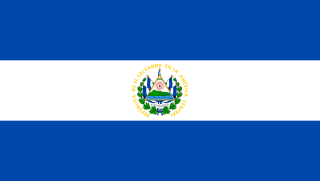Related Research Articles

Central America is a subregion of the Americas. Its political boundaries are defined as bordering Mexico to the north, Colombia to the south, the Caribbean Sea to the east, and the Pacific Ocean to the west. Central America usually consists of seven countries: Belize, Costa Rica, El Salvador, Guatemala, Honduras, Nicaragua, and Panama. Within Central America is the Mesoamerican biodiversity hotspot, which extends from northern Guatemala to central Panama. Due to the presence of several active geologic faults and the Central America Volcanic Arc, there is a high amount of seismic activity in the region, such as volcanic eruptions and earthquakes, which has resulted in death, injury, and property damage.
There are a number of Spanish units of measurement of length or area that are virtually obsolete due to metrication. They include the vara, the cordel, the league and the labor. The units of area used to express the area of land are still encountered in some transactions in land today.

A manzana is a unit of area used in Argentina and in many Central American countries, originally defined as 10,000 square varas in Spanish customary units. In other Spanish-speaking regions, the term has the meaning of a city block.
In Guatemala the metric system is official but it uses a mixture of U.S., metric and Spanish customary units.
The Men's Association football competition at the 2001 Central American Games took place from 22 November to 2 December at the Estadio Mateo Flores in Guatemala City. This was the seventh Football edition since 1973.
A number of different units of measurement were used in Argentina as its national system was derived from Spanish Castillian. The metric system was legally optional since 1863 and has been compulsory since 1887.
A number of different units of measurement were used in Brazil to measure quantities including length, area, volume, and mass as those units were derived from Portugal and had significant local variances.
A number of different units of measurement were used in Chile to measure quantities like length, mass, area, capacity, etc. From 1848, the metric system has been compulsory in Chile.
A variety of units of measurement were used in Colombia to measure quantities like length, mass and area. In Colombia, International Metric System has adopted since 1853, and has been compulsory since 1854.
A number of units of measurement were used in Costa Rica to measure measurements in length, mass, area, capacity, etc. In Costa Rica, metric system has been adopted since 1910, and has been compulsory since 1912, by a joint convention among Costa Rica, Guatemala, Honduras, Nicaragua and Salvador.
A number of units of measurement were used in Nicaragua to measure measurements in mass, area, volume, etc. In Nicaragua, the metric system was adopted in 1910, and has been compulsory since 1912, by a joint convention between Costa Rica, Guatemala, Honduras, Nicaragua and El Salvador.
A number of units of measurement were used in Cuba to measure quantities like mass, area, and capacity. In Cuba, Metric system has been compulsory since 1858.
A number of units of measurement were used in Mexico to measure length, mass, area, capacity, etc. The Metric system was optional from 1857, and has been compulsory since 1896.
A number of units of measurement were used in Paraguay to measure quantities including length, mass, area, capacity, etc. Metric system had been optional since 1890, and adopted since 1899 in Paraguay.
A number of units of measurement were used in Peru to measure length, mass, area, etc. The Metric system adopted in 1862 and has been compulsory since 1869 in Peru.
A number of units of measurement were used in Venezuela to measure quantities like length, mass, etc. Metric system was optional in Venezuela since 1857, and has been compulsory since 1914.
This is a list of the Honduras national football team results from 1960 to 1979.

This article provides details of international football games played by the El Salvador national football team from 1921 to 1949.

This article provides details of international football games played by the El Salvador national football team from 1950 to 1969.
References
- 1 2 3 4 5 6 7 8 Washburn, E.W. (1926). International Critical Tables of Numerical Data, Physics, Chemistry and Technology. New York: McGraw-Hil Book Company, Inc. p. 5.
- 1 2 3 4 5 6 Cardarelli, F. (2003). Encyclopaedia of Scientific Units, Weights and Measures. Their SI Equivalences and Origins . London: Springer. pp. 157, 158. ISBN 978-1-4471-1122-1.
- 1 2 3 4 5 6 Rowlett, Russ (2018). "How Many? A Dictionary of Units of Measurement". ibiblio. University of North Carolina at Chapel Hill. Retrieved 25 March 2020.
- ↑ Technical Conversion Factors for Agricultural Commodities. Rome: Food and Agriculture Organization of the United Nations. 1972. p. 155.
- ↑ World Weights and Measures. Handbook for Statisticians (Statistical Papers. Series M no. 21 Revision 1. (ST/STAT/SER.M/21/rev.1) ed.). New York: United Nations: United Nations. Department of Economic and Social Affairs. Statistical Office of the United Nations. 1966.